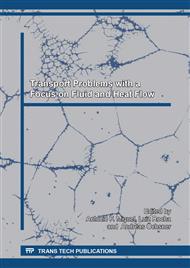[1]
Kwonse Kim, Dooseuk Choi, Analytic Visualization on Chocking Characteristics of Velocity according to a Change in Mass Flows and Plunger Gaps within NGV Injector, Advances and Applications in Fluid Mechanics, 19 (3), 2016, pp.631-642.
DOI: 10.17654/fm019030631
Google Scholar
[2]
A.M. Pourkhesalian, A.H. Shamekhi, F. Salimi, Alternative fuel and gasoline in an si engine: a comparative study of performance and emissions characteristics, Fuel, 89 (5) (2010), p.1056–1063.
DOI: 10.1016/j.fuel.2009.11.025
Google Scholar
[3]
Kwonse Kim, Dooseuk Choi, Optimized Pressure Determined in Accordance with Variable Plunger Stroke of Internal Injector NGV, Defect and Diffusion Forum, 307(2016), pp.41-51.
DOI: 10.4028/www.scientific.net/ddf.370.41
Google Scholar
[4]
M. Kalam, H. Masjuki, An experimental investigation of high performance natural gas engine with direct injection, Energy, 36 (5) (2011), p.3563–3571.
DOI: 10.1016/j.energy.2011.03.066
Google Scholar
[5]
Kwonse Kim, Dooseuk Choi, Study on distributing pressure and velocity on Exhaust Variable Valve Face of Back Pressure, Journal of the Korea Academia-Industrial cooperation Society (KAIS), 15 (4) (2014), pp.1-6.
DOI: 10.5762/kais.2014.15.4.1825
Google Scholar
[6]
Libing Wang, Jihad A. Badra, William L. Roberts, Tiegang Fang, Characteristics of spray from a GDI fuel injector for naphtha and surrogate fuels, Fuel, 190 (15) (2017), pp.113-191.
DOI: 10.1016/j.fuel.2016.11.015
Google Scholar
[7]
Chunde Yao, Peilin Geng, Zenghui Yin, Jiangtao Hu, Yusheng Ju, Impacts of nozzle geometry on spray combustion of high pressure common rail injectors in a constant volume combustion chamber, Fuel, 179 (1) (2016), pp.235-245.
DOI: 10.1016/j.fuel.2016.03.097
Google Scholar
[8]
H.K. Suh, C.S. Lee, Experimental and analytical study on the spray characteristics of dimethyl ether (DME) and diesel fuels within a common-rail injection system in a diesel engine, Fuel, 87 (2008), p.925–932.
DOI: 10.1016/j.fuel.2007.05.051
Google Scholar
[9]
S.H. Park, H.K. Suh, C.S. Lee, Effect of cavitating flow on the flow and fuel atomization characteristics of biodiesel and diesel fuels, Energy Fuels, 22 (2008), p.605–613.
DOI: 10.1021/ef7003305
Google Scholar
[10]
K. Ramamurthi, K. Nandakumar, Characteristics of flow through small sharp-edged cylindrical orifices, Flow Meas Instrum, 10 (1999), p.133–143.
DOI: 10.1016/s0955-5986(99)00005-9
Google Scholar
[11]
Payri, F.J. Salvador, J. Gimeno, J. Morena, Study of cavitation phenomena based on a technique for visualizing bubbles in a liquid pressurized chamber, Int J Heat Fluid Flow, 30 (2009), p.768–777.
DOI: 10.1016/j.ijheatfluidflow.2009.03.011
Google Scholar
[12]
C. Arcoumanis, M. Gavaises, Linking nozzle flow with spray characteristics in a diesel fuel injection system, Atomization and Spray, 8 (1998), p.307–347.
DOI: 10.1615/atomizspr.v8.i3.50
Google Scholar


